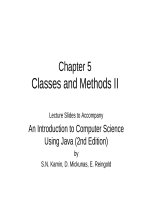Lecture An introduction to collective bargaining and industrial relations (4e) – Chapter 8: The negotiations process & strikes
Bạn đang xem bản rút gọn của tài liệu. Xem và tải ngay bản đầy đủ của tài liệu tại đây (736.86 KB, 43 trang )
Chapter
8
The Negotiations Process &
Strikes
McGrawHill/Irwin
An Introduction to Collective Bargaining & Industrial Relations, 4e
Copyright © 2008 The McGrawHill Companies, Inc. All rights reserved.
1 3
8 3
The Four Subprocesses of Negotiations
• Walton and McKersie argued that there are four
subprocesses of bargaining within the negotiation of
any collective bargaining agreement:
Distributive bargaining
Integrative bargaining
Intraorganizational bargaining
Attitudinal structuring
1 4
8 4
Distributive Bargaining
• Distributive bargaining involves negotiations in which
one side’s gain is the other’s loss
It is a winlose or zerosum bargaining
• Wages are an example: If management grants a
wage increase, workers gain financially at the
expense of shareholders
This type of bargaining leads to conflict
• Unions try to make management agree by
threatening a strike, while management may
threaten layoffs
1 5
8 5
Integrative Bargaining
• Provides gains to both unions and management
A “winwin” negotiation
Labor and management both gain when they
resolve problems that impede productivity and
organizational performance
The introduction of new technology can provide an
avenue for integrative gains, since it works best
with appropriate changes in work practices
1 6
Why Integrative Bargaining Can Be
So Difficult
8 6
• Integrative issues contain the promise of joint gains
• But the parties are simultaneously confronted with
how to divide any joint gain
Thus, integrative bargaining prompts the
occurrence of distributive bargaining
Integrative solutions are sometimes blocked by
labor and management’s disagreement over how to
divide the productivity gains
1 7
Integrative and Distributive Bargaining
Involve Different Tactics
• Integrative bargaining is difficult because parties send
confused signals to each other
They both require very different tactics
• In distributive bargaining, demands are
overstated, information withheld, and a tough
image projected
• In integrative bargaining, an open exchange of
information and airing multiple voices
Integrative bargaining can also be difficult since the
problems that impede productivity are not always
obvious
8 7
1 8
8 8
Intraorganizational Bargaining
• Occurs when there are different goals or preferences
within either side
Unions commonly experience differences between
senior and junior members
Senior members want higher pensions while
younger workers prefer upfront wage increases
Surface bargaining, or “shadow boxing,” occurs
when a representative lacks authority
1 9
8 9
Attitudinal Structuring
• Negotiations involve uncertainty
• It’s difficult to anticipate how much strike
power each side possesses
Attitudinal structuring is the degree of trust the
sides feel toward each other
If both sides share a high degree of trust,
integrative bargaining is easier
• If both sides work together amicably, their
“perspectivetaking ability” is greater and
integrative bargaining is more likely to succeed
1 10
8 10
Management’s Objectives
• The development of wage targets is the heart of the
internal management planning process in the early
stages of negotiations
The negotiating team must recommend targets that
reflect top management’s goals
If they are rejected, the team loses influence and
credibility with top management
1 11
8 11
The Union’s Targets
• Management must take the union’s preferences into
account when setting bargaining targets
Unless management totally dominates the
bargaining, they must consider the acceptability of
their wage offer to the union
The union’s bargaining power determines the
extent to which management considers union
preferences
1 12
8 12
Local Labor Market Comparisons
• If an employer ignores the local job market, high
turnover or low morale could result
Employers do not always pay the lowest wage possible
in their labor market
Paying higher wages will attract better qualified workers
and reduce training costs and turnover
Labor market comparisons are more likely to be used
where the union is weak
Where the union is strong, their bargaining power is used
to do better than the local market
1 13
8 13
Product Market Factors
• Competition on the basis of lower labor costs has
been the dominant factor in management’s drive to
hold down labor costs
Particularly in low skill jobs
• The threat of outsourcing has been an important part
of management’s approach to negotiations in recent
years
1 14
8 14
The Firm’s Ability to Pay
• The effects of wage adjustments on profits also
influence management’s wage target
This is especially salient in small firms and firms
facing a weak union
Management tries to shift from cost of living
issues to the firms ability to pay
• Unions are reluctant to lower their requests unless the
firm can demonstrate economic crisis
1 15
8 15
Internal Comparisons
• Every negotiation is watched by the firm’s other
employees
Management must consider the cost of pay
increases to other union and nonunion employees
in the firm
They often consider if unionized hourly worker
increases will lead to raises for supervisors and
other whitecollar employees
1 16
8 16
The Dynamics of Management’s Decision
Making Process
• The process of establishing management bargaining
strategies involves extensive intraorganizational
bargaining
This can be as intense as the bargaining with the
union
The process is replete with ambiguities and
conflicts of authority
Management continually tries to predict what is
required for a settlement
1 17
Union and Worker Involvement in
Negotiations
8 17
• The Role of the Union Negotiating Committee
The makeup of the union committee varies across
unions
• Typically includes some union officers, support
staff, and elected worker representatives
• The committee will meet prior to negotiations
to establish strategy and demands
• They typically solicit issues from the
membership
1 18
Acquisition of Strike Authorization if at
Impasse
8 18
• If a union comes to an impasse with management,
typically two steps occur:
The local union seeks a strike authorization from
membership
Authorization is needed from the national union
• Strike approval is an important process, since it
enables striking workers to receive strike
benefits from the national union
• Union will typically poll members before a strike
1 19
8 19
Contract Ratification
• When an agreement is reached between management
and the union negotiating committee, the union begins
contract ratification procedures
Some unions send the agreement to a council of
lower level officers for review
Union constitutions typically require that members
vote on a new contract
1 20
Union Leaders’ Roles in Shaping
Strategies
8 20
• Leaders must discard unrealistic goals of the
membership
The goals of older, more skilled workers may
prevail in selecting preferences for bargaining
Union leaders may ultimately consider union
security over members’ wishes
Communications, upward and downward, are key
to effective leadership
Unions use modern media – including the Internet
– to communicate with their members and the
public
1 21
8 21
The Cycle of Traditional Negotiations
• The Early Stages
Both parties present their opening proposals
Some proposals may be critical to the parties
Others may be withdrawn at various stages of
negotiation
The involvement of different representatives can
smooth intraorganizational bargaining within the
union
1 22
8 22
The Presentation of a Laundry List
• The union can recognize the interests of various
constituencies by including them in the laundry list
Some issues will be aired and then disposed of
without agreement
This process takes the pressure off of the union
leadership
A long list of demands can also be used to
camouflage the real priorities of the union
1 23
8 23
Employer Behavior in the Early Phase
• Employers often present their own laundry list
They will often delay wage and major economic
agreement until the late stages of the negotiations
• Wage issues can be emotional and divisive
“Grandstanding” on both sides may take place in
the discussions
1 24
8 24
The Middle Stages
• The middle stages involve more serious
considerations
• Both sides estimate the relative priorities
• They estimate if an agreement can be reached without
a strike
• Signal issues of possible compromise
1 25
8 25
The Final Stages
• The final stages begin as the strike deadline
approaches
• Offthe record discussions may take place between
two individuals or small groups from both sides
Sometimes with the assistance of a mediator
Each party is trying to convince the other of the
credibility of its threats
They try to get the other side to decrease their
bottom line
Each tries to assess the other’s “real” positions









